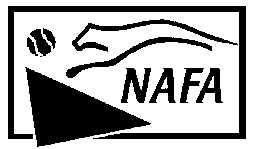
Articles of a broader interest to Flyball enthusiasts are published in The Finish Line.
Copyright © 1996 by NAFA. Contents may be reproduced for use by members of teams associated with NAFA. Others may reproduce providing credit is given to NAFA.
| NAFA and the NAFA logo are registered trademarks of the North American Flyball Association, Inc. |
I would like to thank everyone who co-operated with NAFA in its attempt to trade mark "Flyball". Unfortunatly our appeal was rejected a second time and we have chosen not to appeal further. This means we can once again refer to Flyball as a sport Our application for "NAFA" and our "logo" are proceeding and everything looks positive.
The EJS has been working flawlessly (knock on wood), shipping the system via air seems to cut down on the wear and tear, and surprisingly is cheaper and faster than other methods.
Melanie Davidson asked me to relay the following message. NAFA needs notification in writing when there is a change in dog ownership. We need the complete address of the new owner. You should also notify NAFA in writing when you change clubs with a dog.
After 3 months of the breakout rule, I still have heard no major complaints and most comments are still positive. How would you feel about cutting it back from 1 sec. to a 1/2 sec.
In closing, don't forget that there are three seats coming open on the Board this fall.
Oh, by the way, how many of you know what Hog Fuel is??
(No responses from BC please.)
Tournament Directors: NAFA EJS transportation box lock combinations: Green (Canadian) box (from left): 3228. Red (U.S.) box: 173.
One of the main topics at the Board Meeting was the number of new
teams and tournaments this year. Western Canada and Washington State
in particular are growing rapidly. More tournaments are having to
resort to using two rings and two sets of EJS. With all these added
demands for the EJS, it is becoming very apparent that we require
another EJS as soon as possible.
In travelling around to tournaments and demos, I find that one of the
main features when explaining Flyball to new people, is the fact that
in almost all Divisions in a tournament are now very well balanced.
Teams are finding that there is only 0.5 to 0.75 seconds from first
seed to last seed within their division. This makes for great racing,
no matter what division the newcomers are watching.
I hope that wherever you live, the summer weather is co-operating and
everyone enjoys a great summer.
A Question:
How do people feel about NAFA making its mailing list available to
members of NAFA? Contact Melanie if you have an opinion on this.
NAFA Fees: The Board has decided that they will start accepting the
equivalent in Canadian currency as payment for NAFA fees. Teams
making payments in Canadian dollars should check the exchange rate and
calculate the Canadian dollar equivalent.
Extra sets of Electronic Judging Systems at tournaments: Some of
the larger tournaments are run in double rings which require two sets
of EJS. The Board has decided to charge a flat fee of $100 for extra
lights, NAFA will pay the shipping charges. This is subject to the
second set of EJS being available.
Judge Ages: Amend Sec. 6.5(h): The minimum age for judges is 18 years
old. Line or Box judges under the age of 18 must have prior approval
from the Regional Director.
Sec 6.6(c): This section has been strengthened. It will now read:
"A judge is not to engage in conversation with a disgruntled
exhibitor. The Head Judge may excuse any person for breach of the
Code of Ethics (Sec 6.4)
Sec 1.3(d) The Regional Director shall: (v) have the authority....
prejudicial to the sport of Flyball. The Regional Director may excuse
any person from a tournament for breach of 6.4 - Code of Ethics;
Clarification of 6.16(b): This rule will now read: ....If the handler
or object crosses the start/finish line during his/her dog's run, the
dog must run again.... This change makes the rule consistent with the
line judges guidelines in section E.7.
Effective September 1, 1996.
Change to Break-out Rule 5.5 (a): .... will be declared the loser of
the heat and will not be awarded NAFA Points... NOTE: Tournament Time
Sheets should be marked BO, show no time, and indicate a loss.
NAFA has also developed a new design for the Time Sheet that it is
hoped will be easier for everyone to use.
New Judges: Four apprentice judges have completed their provisional
assignments and are fully qualified. Congratulations to:
Send your nominations to:
You may include a half page (about 500 word) resume for the candidate.
Words from the Chairman
by Bob Murray
Productive Board Meeting in Detroit
This July issue of the NAFA NEWS is being typed in August. This is
partly because there was a large number items that the Board wanted
brought to the member teams' attention following the July 13 Board
Meeting in Detroit.
Items from the Board Meeting
Flyers: NAFA® would like to get more promotional
brochures printed. The Board is wondering if there are any Flyball Enthusiasts
with contacts in the printing business who would be interested in taking on
this task. Contact Clyde Moore for all the details.
Policy Changes
Effective immediately.
Doug. Chalmers, Todd Heineman, Dale Smith, and Annette Tindall.
Reminder...Nominations...Reminder
For the Board of Directors: Three positions come open this year for
the three year term 1997 to 1999.
NAFA Nominating Committee c/o John Cocking
By: September 30, 1996.
R.R. #2
Fisherville, ON
N0A 1G0
Next Board Meeting
Las Vegas NV, Friday November 1.
NAFA Annual Meeting
Las Vegas NV, Saturday November 2 (evening).